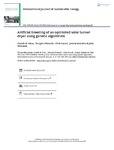| dc.contributor.author | Kituu, Gareth M. | |
| dc.contributor.author | Shitanda, Douglas | |
| dc.contributor.author | Kanali, Chris | |
| dc.contributor.author | Mailutha, Joseph | |
| dc.contributor.author | Wainaina, John | |
| dc.date.accessioned | 2018-12-03T12:09:49Z | |
| dc.date.available | 2018-12-03T12:09:49Z | |
| dc.date.issued | 2011 | |
| dc.identifier.issn | 1478-646X | |
| dc.identifier.uri | http://ir.mksu.ac.ke/bitstream/handle/123456780/2084/Artificial%20breeding%20of%20an%20optimized%20solar%20tunnel%20dryer%20using%20genetic%20algorithms.pdf?sequence=1&isAllowed=y | |
| dc.description.abstract | Studies were carried out to artificially breed an optimized solar tunnel dryer using genetic algorithms (GAs). The energy harnessed by the dryer was simulated in Visual Basic Script (Microsoft Visual Basic Script 2010TM) and the model was used to optimize the dryer by executing the Goal GA. The optimized dryer was developed and tested for energy harnessing against an existing solar tunnel dryer.The results of the analysis showed an 18–113% increase in plenum chamber temperature for the two dryers. Further, a two-wayanalysisofvariancedemonstratedtheexistenceofahighlysignificantdifferencebetweenplenum chamber temperatures for the two dryers (F =16.37, Fcrit,0.99 =2.89). Furthermore, regression analysis andStudent’st-testestablishedtheperformanceoftheoptimizeddryertobesuperiortothatoftheexisting dryer. Finally, this study showed the effectiveness of Goal GA in artificial breeding of an optimized solar tunnel dryer. | en_US |
| dc.language.iso | en_US | en_US |
| dc.publisher | International Journal of Sustainable Energy | en_US |
| dc.subject | Artificial breeding | en_US |
| dc.subject | Genetic algorithm | en_US |
| dc.subject | Solar tunnel dryer | en_US |
| dc.subject | Optimization | en_US |
| dc.subject | Simulation model | en_US |
| dc.subject | Plenum chamber temperature | en_US |
| dc.title | Artificial breeding of an optimized solar tunnel dryer using genetic algorithms | en_US |
| dc.type | Article | en_US |

